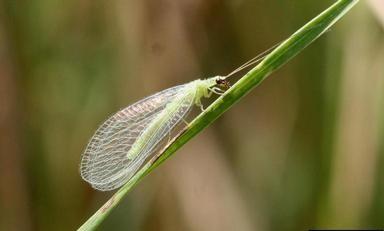Lacewings are beneficial insects in a garden
-
Lacewings are popular, commercially available beneficial insects. Green lacewings are the most common, but brown lacewings are also available. Distribute eggs or larvae evenly around infested plants to minimize cannibalism and to maximize their usefulness as biological control organisms.
-
Lacewing adults are delicate, green or brown, with small heads, and large eyes. The wings are longer than the body, transparent, with a fine network of veins, and are about 1/2 to 3/4 of an inch long.
-
The larvae are alligator-like in appearance, spindle shaped, yellow to brown in color, and mottled. They have spines along their sides and long curved mouthparts (mandibles).
-
Eggs of lacewings are often found in great numbers on plants infested with prey such as aphids or mites. Eggs of green lacewings are laid on the end of long, fine stalks, and are often attached to leaves or twigs.
-
Lacewings are excellent predators of aphids and other small insects.
-
Hatching larvae will eat anything they encounter, size permitting, including siblings.
-
They eat aphids, lace bugs, caterpillars, larvae of some beetles, insect eggs, and mites.
-
Ants foraging on plants are a major predator of lacewing eggs and larvae.




